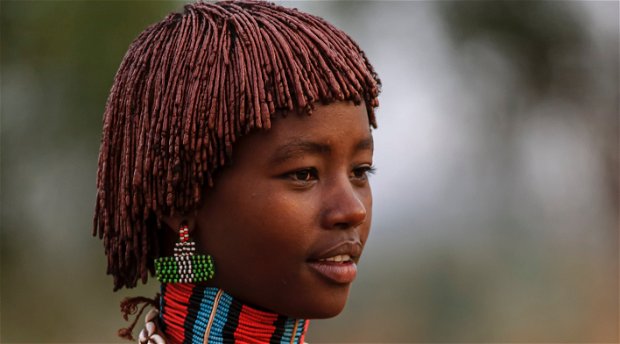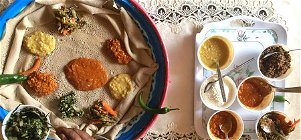Experience 56 Ethnic groups in 7 days

Ethiopia represents a remarkable mosaic of humanity. According to the latest census, there are 94 ethnic groups which speak a total of more than 70 languages belonging to four major language families: Semitic, Cushitic, Omotic, and Nilo-Saharan. The largest number of ethnic groups is in the South, particularly in the lower Rift Valley and the South Omo Valley. Visitors are invariably amazed that so many distinct cultures have developed in such close proximity.
This itinerary takes you to the South Omo Valley where you experience the highly unique traditions, seen today in their ritual, dance, crafts, food and adornments.
When visiting the Omo, taking in at least one market is important so when planning your arrival date, you should take note of the market days mentioned at the end of the itinerary
Source Ethiopia Tours (SET) 002
Title: Experience 56 Ethnic groups in 7 days
Day 1: Arrive in Addis Ababa; met by Source Ethiopia Tours representative at the airport and transferred to the hotel.
In the capital, we explore the sites including the National museum, Entoto Park, Markato and the others. We also organize authentic traditional cooking experience with local market visit at our home. The visitors will have hands-on experience cooking with us, enjoy meal with our family and finally experience the splendid coffee ceremony with the lovely stories.
Addis Ababa (meaning “New Flower” in Amharic):
Addis Ababa is the capital of Ethiopia since 1886/1887. It’s a cosmopolitan city with representatives from over 80 nations and nationalities; and housing more than 70 Embassies. The population of the city is close to 6 million and the elevation varies from 2300 – 2800 meter above sea level.
Day 2: An early start around 7.30 and we then head down the western side of the Rift Valley and our destination today is Hawassa via Ziway.
It’s a long day’s drive, about 7-8 hours with lunch and coffee stops, but it is on a good asphalt road. The scenery is very attractive. There are interesting places to be visited en route – the Neolithic site and museum at Melka Kunture, the UNESCO World Heritage Site at Tiya, and the rock hewn church at Adadi Mariam, contemporaneous with the churches of Lalibela.
The City of Hawassa:
The lakeside town of Hawassa is one of Ethiopia’s most attractive cities. And the Lake, with hippos and rare birds as its star attractions, this scenic body of water (small by Rift Valley standard) can be explored by boat or via a walk along its shore. The fish market is along the shore of the lake every early morning worth visit.
Day 3: This morning, we will experience the fish market along the shore of the Lake with a bird watching opportunity and then drive to Arbaminch. Before we get to our destination, we will visit the Dorze people living in the highland part of the area.
Dorze Village:
Ethiopia’s most admired weavers, the Dorze craft colorful robes and shawls as well as fine baskets, pottery and leather work. Enset (false banana) - the staple food- is found in nearly every compound along with cabbage, tobacco and various spices.
The compounds are major draws, with unique beehive-shaped huts (wajja) up to 10 meters in heights. Wajja are made from woven bamboo, with enset leaves providing the roofs thatching. Light and cleverly designed, wajja can easily picked up and moved when termites invade the area. Incredibly, wajja last 40 to 60 years. The spacious interior’s partitions separate the living rooms, bedroom and space for cattle.
The roughly 12,000 Dorze speak a language from the Omotic family and are believed to have emigrated to their highland area at least 500 years ago. Today, most practice Orthodox Christianity.
Day 4: Today, before heading to Konso, we will experience boat ride on Lake Chamo (one of the Rift Valley lakes) and enjoy viewing hippos, crocs and some aquatic birds. Then, proceed to Konso and after lunch visit the Konso village.
Konso Village:
When you see women wearing colorful double-layered skirts and men in blue –and – white striped shorts, you are in Konso territory. The 300,000 Konso people are spread across 42 villages, most on hilltops and surrounded high stone walls – built centuries ago as a defense against outsiders and from other Konso villages. Elaborate stone terracing systems help retain moisture and prevent erosion on the steep hillsides. On these terraces the Konso grow sorghum, millet, corn, peas and sunflowers. The Konso are also well-regarded artisans. Weavers make the traditional skirts and shorts, smiths craft bronze earrings and bracelets. Woodcarvers create the famous waka funerary statues. The Konso language is in the Cushitic family, and while little documentation exists it is thought that the Konso have inhabited this area for at least four centuries.
Day 5: We leave Konso and drive through the Woito to Turmi – the territory of Hamer people.
The Hamer people:
The Hamer are renowned throughout Ethiopia-and beyond. The tribe, whose population numbers around 45,000 are agro-pastoralists; focusing primarily on raising cattle but also on cultivating sorghum, millet, tobacco and honey. Both women and men are striking to be hold. Women, who usually twist their hair into red tresses using mud and butter, often wear leather skirts dotted with cowry shell, bead necklaces and copper bracelets. Men who have killed an enemy or large animal in the past year wear their hair in buns.
The most important event in the life of a Hamer male is the bull-jumping ceremony-a rite of passage and a prerequisite for marriage. A row of eight to ten bulls is formed and the naked initiate must traverse the row, leaping from one animal to next four times. If successful, his male relatives then flog the backs of his female relatives, who see this as a chance to prove loyalty and courage.
Day 6: Today, we do excursion to Omorate, cross the Omo River and experience the Dassanech people.
The Dassanech people:
Inhabiting the dry and harsh territory near the borders with Kenya and South Sudan, the formerly nomadic Dassanech come from two ethnic groups. Of the eight Dassanech clans, six are believed to be from Somalia and the other two from Kenya. The estimated 48,000 Dassanech are pastoralists who raise livestock.
For the six clan from Somalia, the most important ritual is the female rite of passage. During the dimi, up to ten families pool resources to celebrate the transfer to womanhood of their 12-to-14 year’s olds. Brothers and uncles of the girls slaughter cattle for the feast, which is accompanied by a unique stick dance. The girls, along with their parents, wear newly made clothing and ornaments. The celebration is very costly, but if a girl doesn’t undergo this ritual, her family belongings could be destroyed and their cattle stolen.
Day 7: This morning we leave to Jinka via Benna people village and Key afer (famous for its Thursday colorful market).
South Omo Research Center ( Jinka Museum):
At this museum you will explore the traditions of the 16 ethnic groups in South Omo Zone. For instance, discover why the Hamer boys jump on the backs of cows and Mursi women wear clay lip plates. South Omo Valley’s largest town – with a Saturday market – Jinka is a stopover for those en route to Mago National Park and the Mursi area.
Day 8: We leave Jinka and drive to the Mago National Park. The park has a variety of mammals and birds, but the animals tend to stay away from the roads and sightings cannot be guaranteed.
The main attraction in Mago are the Mursi people, so we drive to Shembel, the nearest Mursi village and if we want to go further, up the escarpment to the Mursi villages there. The Mursi go in for body scarification and (among the women) the wearing of lip plates.
The Mursi people:
Perhaps no other tribe has been the subject of such academic and touristic curiosity, in large part because of its distinctive appearance. The roughly 10,000 Mursi, whose language is in the Nilo-Saharan family, are seminomadic. While they are primarily pastoralists, tsetse fly infestation in some area has promoted the need for agricultural activities.
A Mursi women is highly recognizable because of her lip plates – a sign of beauty whose size signifies dowry amount. Up on reaching adolescence, a girl’s lower lip is cut and a clay or wooden plate is inserted. As her plate stretches, progressively larger plate is inserted. Men also have a challenging path to marriage: They must emerge victorious from a stick fight called donga. The loser is often beaten nearly to death, while the winner is serenaded by girls standing on a special platform.
Day 9: Fly back to Addis Ababa and final departure.
Colorful market days’ worth visit on this route:
- Monday: Turmi, Konso and Kako
- Tuesday: Dimeka, Jinka and Alduba
- Wednesday: Konso
- Thursday: Chencha (afternoon), Konso and Key Afer
- Saturday: Dimeka, Erbore, Jinka and Key Afer
- Sunday: Weito
P.S: There are daily markets in Jinka and Omorate, but the markets in Omo Rate are not so interesting.
Itinerary
Day 1:
Arrive in Addis Ababa; met by Source Ethiopia Tours representative at the airport and transferred to the hotel.
In the capital, we explore the sites including the National museum, Entoto Park, Markato and the others. We also organize authentic traditional cooking experience with local market visit at our home. The visitors will have hands-on experience cooking with us, enjoy meal with our family and finally experience the splendid coffee ceremony with the lovely stories.
Addis Ababa (meaning “New Flower” in Amharic):
Addis Ababa is the capital of Ethiopia since 1886/1887. It’s a cosmopolitan city with representatives from over 80 nations and nationalities; and housing more than 70 Embassies. The population of the city is close to 6 million and the elevation varies from 2300 – 2800 meter above sea level.


Share This Page